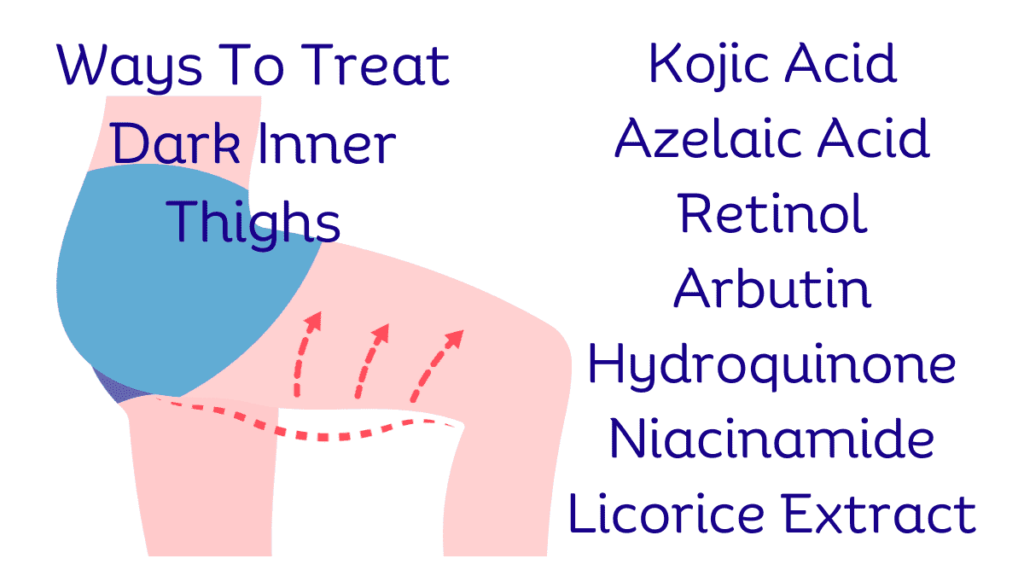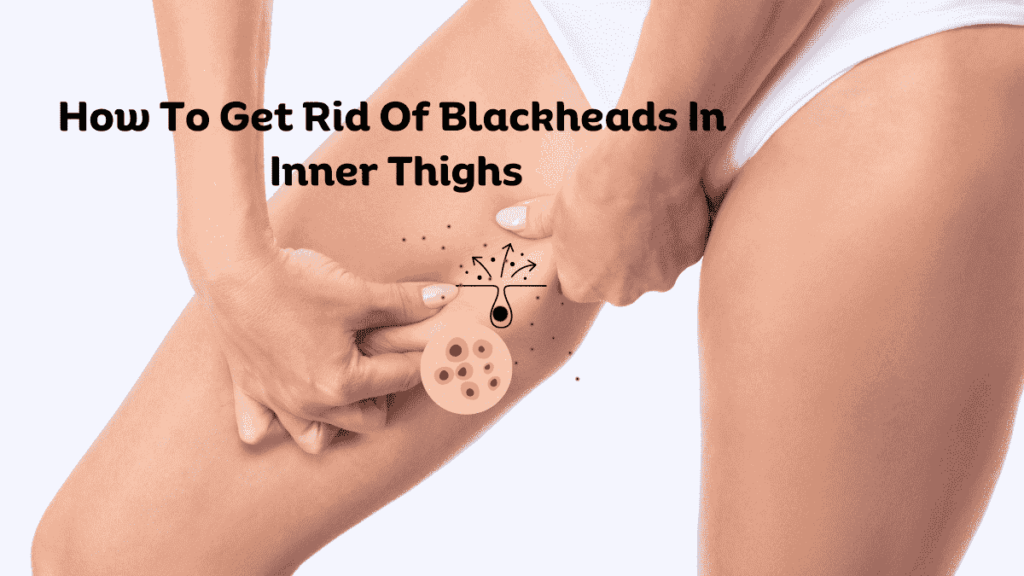Why Blackheads form on your inner thighs
Blackheads on your inner thighs Skin are small, dark bumps caused by clogged hair follicles. They’re a type of acne called open comedones. They might look unpleasant and feel uncomfortable if they get red or infected due to their significant impact can causes Mood Disorders , depression, anxiety. They occur when excess oil, dead skin cells, and bacteria clog the pores around hair follicles·
Tight or non-breathable clothing can rub against your skin, trapping sweat and oils that block pores. Inner thighs sweat more in hot weather, which mixes with oils and can clog pores or bumps skin not exactly like skin tag.
Shaving can irritate hair follicles and cause ingrown hairs, leading to more blackheads. Hormonal changes during puberty, menstruation, or pregnancy can also increase oil production and make blackheads more likely. Not cleaning the inner thighs well enough can let dirt, sweat, and bacteria build up which worsens blackheads.
For those dealing with acne scars caused by blackheads or other types of acne, exploring natural remedies for acne scars can be beneficial.
Causes of Blackheads on Inner Thighs
Blackheads, scientifically known as open comedones, are a type of acne that develop when pores around hair follicles become clogged with excess oil, dead skin cells, and bacteria. Understanding the specific factors contributing to their formation can help in effectively managing and preventing them.
Friction and Clothing
Tight or non-breathable clothing can exacerbate the formation of blackheads on the inner thighs. When fabric rubs against the skin, especially in areas prone to friction or skin-to-skin contact, it can trap sweat and oils. These substances then mix with dead skin cells, leading to blocked pores· To minimize this risk, opt for loose-fitting clothing made from breathable fabrics like cotton, which allow for better air circulation and reduce friction·
Sweat and Oil Production
The inner thigh area is susceptible to increased sweat production, particularly in hot and humid weather conditions or during physical activities. Sweat itself is mostly water but also contains salts and minerals. When sweat mixes with naturally occurring oils (sebum) on the skin’s surface, it can form a sticky residue that clogs pores. This environment is conducive to the proliferation of bacteria, further contributing to blackhead formation· Maintaining good hygiene practices, such as showering after sweating and wearing moisture-wicking fabrics during physical activities, can help mitigate this issue·
Hormonal Changes
Hormonal fluctuations play a significant role in the development of blackheads on the inner thighs. During puberty, the body undergoes hormonal changes that stimulate the production of sebum, the oily substance produced by the sebaceous glands. Increased sebum production, coupled with the shedding of dead skin cells, can lead to pore blockages and the formation of blackheads·
Similarly, hormonal changes associated with menstruation, pregnancy, and conditions like Polycystic Ovary Syndrome (PCOS) can also contribute to heightened sebum production, making individuals more prone to blackheads·
Hygiene Practices
Proper hygiene practices are crucial in preventing the buildup of dirt, sweat, and bacteria that can exacerbate blackhead formation on the inner thighs. Inadequate cleansing allows these impurities to accumulate, leading to blocked pores and potential skin irritation. To effectively cleanse the inner thigh area, use a gentle, pH-balanced cleanser specifically formulated for sensitive or acne-prone skin. Ensure thorough cleansing during showers or baths, paying attention to areas prone to sweating and friction.

Prevention Tips to Avoid Blackheads on Inner Thighs
Blackheads, those pesky open comedones on the inner thighs, can be managed and prevented with simple yet effective measures. Incorporating these tips into your daily routine can help keep your skin clearer and healthier.
Clothing Choices
Opt for clothing made from loose-fitting, breathable fabrics such as cotton. Tight or non-breathable fabrics can increase friction against the skin, trapping sweat and oils that contribute to blackhead formation. By choosing breathable materials, you allow better air circulation, which helps prevent pore blockages.
Hygiene and Cleansing
Maintaining good hygiene practices is crucial for preventing blackheads. Cleanse the inner thigh area daily with a gentle, pH-balanced cleanser. This helps remove sweat, bacteria, and excess oil that can clog pores and lead to blackheads. Use lukewarm water and avoid harsh scrubbing, as this can irritate the skin and worsen the condition.
- Cleansing Technique: Apply the cleanser gently using circular motions, ensuring thorough coverage of the inner thigh area. Rinse with lukewarm water and pat dry gently with a clean towel afterward. Avoid rubbing vigorously to prevent irritation.
Powder Usage
Consider using talcum powder or non-comedogenic powders on the inner thighs, especially during hot and humid weather. These powders help absorb excess moisture, keeping the skin dry and reducing friction. Be sure to apply a thin, even layer to avoid buildup that could clog pores.
Avoiding Irritation
Be cautious when shaving the inner thigh area to prevent ingrown hairs, which can lead to more blackheads. Use a sharp, clean razor and shave in the direction of hair growth to minimize irritation. Consider using shaving creams or gels to lubricate the skin and reduce friction. After shaving, apply a soothing moisturizer to hydrate the skin and prevent dryness.
Regular Exfoliation
Incorporate regular exfoliation into your skincare routine to prevent dead skin cell buildup. Use a gentle exfoliating scrub or a soft washcloth 1-2 times per week to slough off dead skin cells and prevent pore blockages. Avoid harsh scrubbing, as this can irritate the skin and exacerbate blackheads.
Effective Treatments for Blackheads on Inner Thighs
Managing blackheads on the inner thighs involves a combination of targeted skincare practices to unclog pores and prevent their recurrence.
Cleansing Routines
Proper cleansing is essential to remove excess oil, sweat, and impurities that contribute to blackhead formation. Use a mild cleanser designed for sensitive or acne-prone skin. Cleanse the inner thigh area twice daily—morning and evening—to keep pores clear and minimize dead skin cell buildup.
- Technique: Apply a small amount of cleanser to damp skin, gently massage in circular motions, and rinse thoroughly with lukewarm water. Pat dry with a clean towel to avoid irritation.
Exfoliation Techniques
Regular exfoliation helps prevent pore blockages by removing dead skin cells. Use a gentle exfoliating scrub or soft washcloth 1-2 times per week on damp skin to promote skin renewal.
- Tip: Avoid over-exfoliation, as it can irritate the skin and exacerbate blackheads. Rinse thoroughly and follow with a moisturizer to maintain skin hydration.
Topical Treatments
Incorporate targeted treatments to unclog pores and reduce blackheads:
- Salicylic Acid: Known for its exfoliating properties, salicylic acid penetrates pores to dissolve oil and dead skin cells. Use an over-the-counter cream or gel with 2% salicylic acid once daily.
- Benzoyl Peroxide: Kills bacteria and helps reduce oil production. Start with a lower concentration (2.5-5%) and apply a thin layer to clean, dry skin once daily.
- Natural Remedies: Diluted tea tree oil or witch hazel, known for their antibacterial properties, can also help manage blackheads. Dilute before applying to avoid skin irritation.
Moisturization
Use a lightweight, non-comedogenic moisturizer to keep skin hydrated without clogging pores. Choose products labeled “non-comedogenic” to prevent further blackhead formation.
- Tip: Apply moisturizer after cleansing and topical treatments to maintain skin balance and hydration.
Additional Tips for Managing Inner Thigh Blackheads
Avoid Touching or Squeezing: Resist the urge to touch or squeeze blackheads on your inner thighs. This can exacerbate inflammation, spread bacteria, and potentially lead to scarring. Instead, focus on gentle cleansing and appropriate skincare treatments.
Hydration and Diet: Maintain skin hydration by drinking plenty of water throughout the day. Hydrated skin is more resilient and less prone to pore blockages. Additionally, incorporate a balanced diet rich in fruits, vegetables, and whole grains· Avoid excessive consumption of sugary or processed foods, which can contribute to skin issues·
Sun Protection: Protect your skin from harmful UV rays by applying a broad-spectrum sunscreen with SPF 30 or higher, especially when using exfoliating treatments.Sunscreen helps prevent UV-induced skin damage and reduces the risk of hyperpigmentation and premature aging·
Consulting a Dermatologist: If blackheads persist despite diligent home care efforts or if you have concerns about sensitive skin, consult a dermatologist. A dermatologist can provide personalized treatment options tailored to your skin type and condition.
They may recommend prescription-strength medications, advanced skincare treatments, or procedures to effectively manage and treat blackheads on the inner thighs.
FAQ
What causes blackheads on inner thighs?
Blackheads on inner thighs are often caused by excess oil production, friction from clothing, or trapped sweat and dirt.
How can I prevent blackheads on my inner thighs?
To prevent blackheads, keep the inner thigh area clean and dry, wear loose-fitting clothing, and use non-comedogenic skincare products.
What are effective treatments for blackheads on inner thighs?
Effective treatments include exfoliating regularly with a gentle scrub, using salicylic acid or benzoyl peroxide treatments, and applying a clay mask to absorb excess oil.
Is it safe to extract blackheads from inner thighs at home?
It’s generally safer to leave extractions to professionals to avoid infection or scarring. Consult a dermatologist for proper extraction.
Can diet affect blackheads on inner thighs?
Yes, a diet high in processed foods and sugars can contribute to excess oil production, potentially exacerbating blackheads. Maintaining a balanced diet can help.
When should I see a dermatologist about blackheads on my inner thighs?
Consider seeing a dermatologist if home treatments aren’t effective, if blackheads are accompanied by pain or inflammation, or if you’re concerned about scarring.
Are there any natural remedies for blackheads on inner thighs?
Natural remedies like tea tree oil, witch hazel, and aloe vera can help reduce blackheads. However, it’s important to patch-test and dilute these before use.
How long does it take to get rid of blackheads on inner thighs?
Results vary, but with consistent treatment and proper skincare, improvement can be seen within a few weeks to a couple of months.
Can hormonal changes affect blackheads on inner thighs?
Yes, hormonal changes can increase oil production, which may contribute to blackheads. Managing hormone fluctuations through lifestyle changes or medication can help.
Are there specific hygiene practices to prevent blackheads on inner thighs?
Yes, showering after sweating, wearing breathable fabrics, and avoiding tight clothing can reduce the likelihood of blackheads on inner thighs.
Conclusion
In conclusion, managing blackheads on the inner thighs involves a multifaceted approach that combines consistent skincare practices, effective treatments, and lifestyle adjustments· By understanding the factors that contribute to blackhead formation and implementing targeted strategies, you can significantly reduce their occurrence and achieve clearer, healthier skin·
Call to Action
We invite you to share your experiences or questions about managing inner thigh blackheads in the comments below·
Your insights and inquiries can contribute to a supportive community seeking solutions for skincare challenges· Remember, for personalized advice and tailored treatment options, consulting a dermatologist is recommended· They can offer expert guidance based on your individual skin type and condition, ensuring you receive the most effective care·
